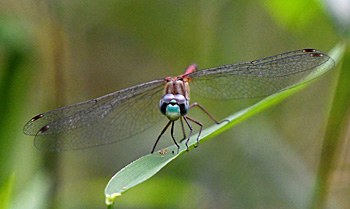Volume 25 Issue 4, Fall 2020
by Anne Owen, Audubon at Home Program Coordinator

AAH Ambassadors Anne Owen and Betsy Martin present the sign that certifies the property is an AAH Wildlife Sanctuary to Black Oak volunteer Sheila Ferguson and Loudoun Wildlife Executive Director Michael Myers. Photo by Michael Sciortino
JK Black Oak Wildlife Sanctuary is not open to the public. Access is restricted to Loudoun Wildlife Conservancy activities.
The Loudoun Wildlife Conservancy and Audubon at Home (AAH) are delighted to announce that JK Black Oak Wildlife Sanctuary is now certified as an Audubon at Home Wildlife Sanctuary.
Loudoun Wildlife’s AAH program, offered in partnership with the Audubon Society of Northern Virginia, focuses on helping property owners to establish and nurture healthy habitat for wildlife here in Loudoun County. We look for three elements that wildlife needs to thrive — water, food, and shelter, both for protection and to raise young, and we also strongly advocate for the nurturing of native plants and for the removal of invasive, non-native plants that take up real estate without providing nourishment. A rich variety of habitat and native plants is known to support diversity in insects, birds, and other critters.
The 89 acres of the JK Black Oak Wildlife Sanctuary offer these key habitat features and variety in abundance!

A Blue-faced Meadowhawk Dragonfly hangs out poolside at the sanctuary. Photo by Michael Myers
Water is present throughout the year in the form of multiple vernal pools, typically only wet in the spring; a further pool that has water all year round; and an extensive wet meadow at the eastern end of the property. Each of these water sources supports different native plant communities, different insect communities, and different birds and animals. For example, the vernal pools are known to support breeding salamanders and Fairy Shrimp that contribute to the carnivorous tadpoles’ diet, while Buttonbush, Wood Ducks, and dragonflies have been observed coexisting at the permanent pool.
Tracts of mixed deciduous forest include at least 17 species of native trees, including the oaks and Black Cherry that top the lists for the number of different Lepidoptera caterpillar species they can support. Remember that caterpillars in abundance are needed to raise baby birds. These quiet forest areas with their associated vines of native Grape, Virginia Creeper, and Poison Ivy, snags, logs, and rocks also provide safe nesting, foraging, and over-wintering locations. The salamanders that breed in the vernal pools spend most of their adult lives in the forest.

The forest at the newly certified sanctuary is filled with many mature native trees. Photo by Michael Sciortino
A continuous succession of seasonal plants and grasses flower in the meadow areas from spring to fall, each one supporting its specialist coevolved insects as well as the generalists. At the time of the AAH visit, the meadows were covered in dense blooms of goldenrods, bidens, and Blue Mistflower, while Jewelweed and New York Ironweed were common finds in the wetter areas. Skippers, grasshoppers, and native bees and wasps were in abundance, offering a fine diet for the Gray Catbirds who we could hear calling continuously. So far, nearly 60 species of native grasses, sedges, forbs, and annual flowering plants have been documented, and we are sure there are many more yet to be found.
The real test of the health of habitat is the number and variety of fauna whose life cycle is supported. For Wildlife Sanctuary certification, AAH requires sightings of at least 10 designated species of native birds, mammals, reptiles, amphibians, and insects that are in need of help in our area due to habitat loss. So far, Loudoun Wildlife volunteers have documented 110 species of birds and 155 species of insects, spiders, reptiles, and mammals — far exceeding the minimum and amply demonstrating the wildlife value of this property. These observations are recorded in Citizen Science projects using iNaturalist and EBird, thereby adding to the scientific knowledge about Black Oak, and its context in Northern Virginia and the Mid-Atlantic region.

A coyote slips through the woods at JK Black Oak during the AAH certification visit. Photo by Michael Myers
Of course, amid all this good news, there’s some bad news too. As former farmland, the Wildlife Sanctuary also has a heavy load of non-native, invasive plants. Sadly, Autumn Olive, Tree-of-Heaven, Oriental Bittersweet, Mile-a-Minute, and Japanese Stiltgrass, to name but a few, are all common. But we know that the Management Plan currently under development will address these issues, and we are very confident that Black Oak will continue to thrive as a Loudoun County jewel.
“We are proud to be stewards of this globally rare wetland, and we are glad this property is permanently protected from future development through a conservation easement,” Loudoun Wildlife Executive Director Michael Myers said as he received the AAH Wildlife Sanctuary sign. “The AAH Wildlife Sanctuary certification is a very welcome recognition of the significance of this property.”

